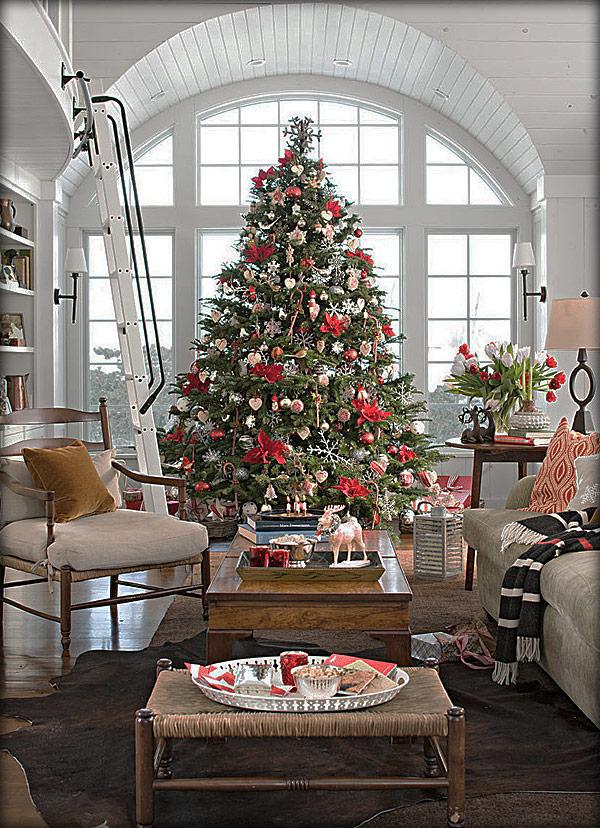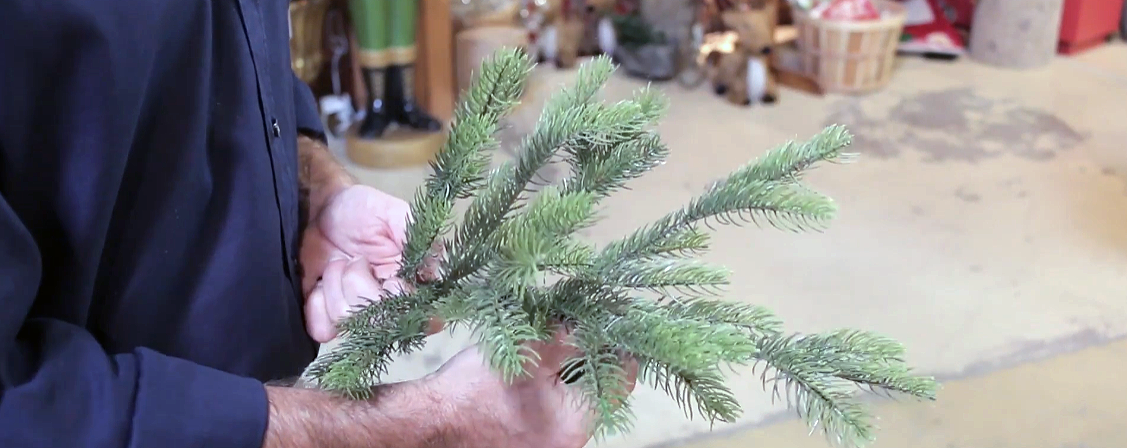Artificial Christmas Tree Buyer's Guide
Artificial Christmas trees have come a long way

There are upscale and well-made choices that mimic real trees amazingly well, and are even categorized by type of trees like: Alpine Fir, New England Spruce, Oregon Pine, California Cedar, and many more. Then there are ones that are designed for a unique look, such as white, silver, black, purple tinsel trees, upside down trees, spiral trees, and even metal sculpted trees. Artificial trees are available in heights to reach the top of cathedral ceilings down to sizes ideal for decorative table-top centerpieces. Choices are available with or without lights and pre-lit versions offer clear and multi-color light options.
Quality considerations span several areas
Sturdiness of stand and structure, quality and density of both branches and lights, and ease of assembly, all of which will be covered in depth later. In general, stands and structures of metal are stronger and safer than lighter and easier to tip plastic versions. The quality of branches greatly affects the look of the tree, and is determined by both material and manufacturing.
Lights should be UL rated for safety, include burn-out protection (so that one light can go out without affecting the others), and shine brightly. For the nicest look, there should be an appropriate ratio of number of lights and branch tips to tree height. Trees made using hinged branch construction are easier to assemble each year than the less expensive hook-in branch versions.
Accessories include Christmas ornaments, of course, as well as Christmas tree skirts, power strip/surge protectors for lighting safety and longevity, lights if the tree does not include them, and tree storage bags or boxes that are dust and insect-proof for off-season protection. Stands are generally included with the trees.
High quality artificial trees are made to last for a decade or more, and often come with warranties to back that up. Warranties for the tree itself are usually longer than for the lights. In general, the one time expense of an artificial tree will cost far less than buying a real tree year after year.
One feature artificial trees don't include is the fresh cut scent, though people with tree allergies won't miss that at all. And for those that do, there are tree fragrance items that just may do the trick.
Choosing The Ideal Artificial Christmas Tree Height
The most important factor in determining the best-sized tree for you is the location where you will put it. Measure both the ceiling height and the width of the floor space available for the tree without it bumping up against furniture, fireplaces or impeding the flow of traffic.
Height:
Generally speaking, the tree height should be at least 6” shorter than the
ceiling height to allow for a tree topper. For a room with a standard 8’ ceiling, a 7-7.5’ tall tree
would be ideal. Rooms with cathedral ceilings may handle a significantly taller tree to make the most of the look
and feel of the space.
Width:
Select the most appropriate width based upon the space. The average width of a
7.5’ tree is 56”; however, 7.5’ trees come in widths ranging from 20” (Slim) to 72”
(Wide) and should be selected based on the width of the floor space and your personal taste.
In very tight spaces, slim trees or other unique options such as flat, half wall, upside down, or table top trees may be good options.
How To Identify A High-Quality Artificial Christmas Tree
Tree Sections
Artificial Christmas trees are constructed in easy-to-manage light-weight sections making assembly quick and simple!
Based on height, trees typically come as follows:
2’ - 5’ : 1-2 sections
6.5’ –
7.5’ : 3 sections
9’ – 10’ : 4-5 sections
12’ – 15’+ : 6-7+
sections
Center Poles And Tree Stands
Constructed with stability and durability in mind, steel center poles and steel tree stands are rated to match each tree’s size and weight (and then some!) so that when the tree is assembled and fully decorated it will have the greatest stability and durability. Small trees and tabletop models are considerably lighter and may only require a plastic stand.

Hinged Branches
Hinged tree branches are permanently attached at the center pole, making tree assembly and fluffing quicker and easier than old-fashioned hook-on or push-in single branch construction. Simply let the branches down, fluff out the foliage, plug in the lights…and enjoy!
Hook-In Branches
With the hook-in variety, you will need to put each branch into a separate hook on the tree pole. Branches are usually color coded so that you will know where they go. Since each branch is attached individually, these trees take far longer to assemble, and are not available as pre-lit trees. However, these are cheaper to purchase. You will not find any Treetime Christmas trees using a hook-in construction. All of Treetime's artificial Christmas trees are fully hinged.
Understanding The Difference In Christmas Tree Foliage
Tip Count Vs. Density
When shopping for trees, you'll find that the tip count is often included in tree descriptions. More important than tip count is the density of branches and needles. For a traditional appearance, you should not be able to see through to the inside of the tree, and there should be enough outer branches to hang your ornaments. Needles should have a lush and thick appearance on the branches.
Unique Material Styles
All artificial trees will be made from either PE or PVC material, or a beautiful combination of them. However, many other unique styles and colors of trees are available, such as:
Flocked– Trees are dressed with a beautiful blanket of white over the green foliage as if they’ve been
outdoors during a recent snow
Frosted– Much lighter than flocking, a very light frost delicately graces
the foliage just a trees look before being warmed by the morning sun
Colored– Trees are also available in
a variety of solid colors including white, silver and platinum, as well as in combinations of sports team-themed
colors.
Real-Needle™ PE
The most realistic foliage type is our Real-Needle™ PE foliage. We take real branches from nature and have molds made out of them giving trees in PE foliage the most realistic impression possible! Most PE trees will have some PVC foliage on them, typically found on the part of the branches nearest the pole; this helps to decrease the overall weight of the tree, and to create fullness deep inside the tree.
Traditional PVC
PVC is the material from which all artificial trees used to be made. The material is cut into thin strips and wrapped onto the branches giving them a fluffy feel and look. Trees made with PVC foliage have a very traditional feel both to the touch and style-wise.
How To Identify High Quality Lighting
 Pre-lit Christmas Tree Light Quality And
Density
Pre-lit Christmas Tree Light Quality And
Density
Lights on a pre-lit Christmas tree should be evaluated based on looks, longevity, and density. They should be high quality and durable, with quality outweighing quantity. Lights should be attached securely, UL rated for safety, include burn-out protection so that one light can go out without affecting the others, and shine brightly. The best milliamp ratings are greater than 170mA, since they will burn out less quickly than those with lower ratings. Lights generally do not last as long as the tree itself, which is why you will notice that a tree may have a 5 season structural warranty while the included lights are guaranteed for 2-3 years. There are non-traditional light options as well, including fiber optic and LED choices.
Light Count Vs. Density
As with branches, density is a more significant quality factor than quantity alone. 80 to 100 lights per foot for a full tree is a high quality ratio. For a seven foot tree, 560 to 700 lights would be top of the line. A thinner tree may have less lights per foot. The best way to judge a pre-lit tree is to look at it and decide for yourself whether it is lit pleasingly.
Quality Lighting Technology
Treetime lighting is an innovation in Christmas lighting and revolutionary to the Christmas industry. Several competing sites will claim to have lights that remain on after a problem occurs, but what you're likely purchasing is a knock-off of this patented, award-winning technology. As many of you know, mini lights are historically the Achilles heel of holiday decorations. The most significant impact that we can have on your overall experience is to supply a lighting system that doesn't exhibit the ongoing failure problems associated with traditional Christmas lighting. Other technologies have been evolving in an attempt to solve some of these problems but have previously been incapable of reproducing what you have come to expect from a quality product.
Industry-Standard Lighting
Currently, no one offers better pre-lit lighting technology than Treetime. This unique design isn't just for reliability but also for looks. There are never more than 50 lights to each set (improves lifespan) and no light set failure will cause a black-out in any portion of the tree except for the bulb that burns out. Even if a bulb does burn out, it will not take out a strand! These are truly commercial-grade mini lights and all Platinum Collection™ Treetime Christmas trees are backed by a 3 season light warranty—the industry's best.
How To Choose The Right Christmas Tree For Ornaments
With a vast range of choices available, there are artificial trees to meet most tastes and needs. Your key decisions will be size (as covered above), pre-lit or not, and traditional vs. unique.
Pre-Lit Or Unlit?
You can choose between pre-lit artificial Christmas trees and trees that do not come with lights. It is easier and more convenient to have the lights included, but they do add to the tree’s cost. Another point to consider is that the artificial tree itself will last longer than the lights; many warranties reflect this fact, with the tree guaranteed for 10 or more years and lights covered for about three. If you choose a pre-lit tree, your main options will be clear or multi-color lights. For many, the appeal of artificial trees is that they save time and are ready-to-go, making pre-lit trees the most popular choice and a desirable option.

Traditional/Realistic Appearance
Traditional artificial trees are made to look like real trees; the higher the tree quality, the more it will succeed at looking natural. These trees usually have dense branches in a medium to dark green color. You'll be able to choose between options that mirror the appearance of numerous tree species, including Alaska Firs, Norway Spruces, Montana Pines, and many more. Heights vary from table-top up to 20 feet and more, with four and a half to 10 feet being the most common. They are available in slim to full shapes.
Unique Trees
Unique trees defy classification. In the realm of unique looks, there are upside down trees, spiral trees, revolving and sparkling fiber optic trees, trees with metallic tinsel needles, sculpted metal trees, and more, in various color and size choices. Some people choose a unique tree in tight spaces, where a traditional full tree just won't work, or as a second decorative tree, perhaps to add a festive spirit to another room or table-top. These trees can be beautiful, vibrant choices that attract attention.
Other Features And Considerations
Some trees include features such as pine cones or berries hanging from branches. Flocked and frosted trees offer a snow-touched look, though keep in mind that the white accents tend to yellow over time.
Your taste in ornaments can affect your tree and light choice. If you have simple ornaments of consistent solid colors, multi-color lights can complement them well. If your ornaments are ornate or varied, the subtle backdrop of clear lights on a fairly conservative tree may be a better look. White trees are known for providing a great backdrop for darker colored ornaments.
The heavier your ornaments are, the sturdier the tree branches need to be. Likewise, the more numerous your ornaments are, the more branches you'll need to support them.
Christmas Accessories And Other Considerations
Make sure you know what is included with your tree. Stands almost always are included, but you will probably
want a decorative tree skirt to hide the structure. Storage bags, usually not included, are necessary to protect
your investment from insects and dust during the off-season. If you are not buying a pre-lit tree, you probably will
want to buy lights. A power strip/surge protector is always a good idea to protect the lights. And of course, don't
forget your ornaments.
Price Range
Prices depend on quality of material and construction, size, and whether the tree is pre-lit. Most high quality, pre-lit, floor size (six to nine feet) trees fall within $139 to $1000 or more; some, mostly on the lower height end, are available in the $150 to $400 range. Lower cost trees are available in smaller sizes or without lights.
